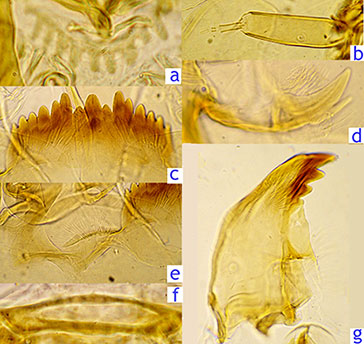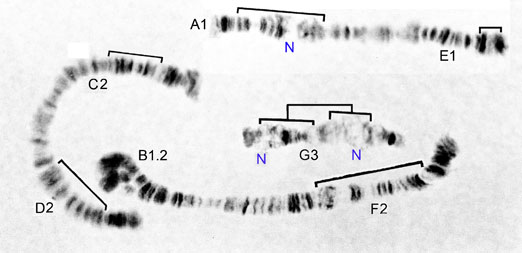C. atchleyiFourth instar larva: a moderately large, relatively slender plumosus-type larva, length about 17.1 (14.0-21.3 mm (female), 15.3 (14.0-16.7 mm) (male). Ventral tubules long, posterior pair coiled and usually slightly longer (ant. 2.31 (1.36-3.10) mm; post. 2.40 (1.80-2.98) mm), lateral tubule well developed (395.5 (300-480) µm). Anal tubules about 3.5 (2.7-4.9) times longer than wide, ventral pair slightly shorter and narrower. Salivary reservoir (Fig. e, below) relatively wide 99.3 (89-109) µm and about 5.0 (4.1-6.1) times wider than deep.Ventral head length 299.5 (260-356) µm; mentum width about 214 (195-240) µm. Head capsule with gula and frontoclypeus normally pale but with slight darkening at Anglesea, Victoria.
Mentum (Fig. e, below) with 4th laterals slightly reduced (type I-ii); and with c2 teeth of central trifid tooth clearly separated and sharp (type IIA) when not worn.
Ventromental plates (Fig. f, below) separated by less than a quarter of the mentum width, about 254.6 (217.5-266) µm wide, 3.75 (3.44-3.98) times wider than deep and about 1.1 (1.04-1.25) times wider than the mentum; about 46 (40-54) striae; VMR about 0.26 (0.21-0.31). Pecten epipharyngis (Fig. a, below) with about 12.8 (11-15) mostly regular teeth (type B).
Premandible (Fig. d, below) of type B1, i.e. inner tooth coming to a broad point, about 3.6 (2.2-5) times wider than the outer tooth.
Basal segment of antenna (c, below) about 3.5 (3.0-3.95) times as long as wide, RO about 1/3-1/2 way up from the base; AR about 2.35 (1.81-2.81); A2/A1 about 0.23 (0.18-0.30), A4/A3 about 1.3-2.5 ; A3 only slightly longer than A5 and may be shorter (A5/A3 0.96 (0.71-1.33)); relative length of segments (micron) 135 : 32 : 8 : 12.5 : 7.5. However the relative lengths of the segments can vary largely between specimens.
Distance between the antennal bases (188 (162-200) µm) usually greater than that between the S4 setae (177 (149-194) µm), which are separated by about 0.78-0.83 of the frontoclypeal width at that point.
Mandible (Fig. g, below) about 259 ((224-298) µm long, with third inner tooth pale but distinct (type IA-IIB), about 19.8 (16-25) furrows on the outer surface near the base and about 11.2 (10-13) taeniae in the Pecten mandibularis; Mdt-Mat about 28 (23-35) µm., MTR 0.32 (0.25-0.39). 
Larval mouthparts of C. atchleyiCytology: 4 polytene chromosomes with the pseudothummi arm combination AE, BF, CD, G.
Arm G normally paired, position of the 2 nucleoli and BRs dependant on sequence. Nucleoli in arms A, F, G and sometimes in B.
Confirmed sequences as follows.
atcA1: 1a-e, 3e - 2d, 8 - 9, 11(NOR) - 10, 2c - 1f, 12c-a, 4 - 7, 3i-f, 13 - 19 as nepA2
atcB1: Nucleolus just distal of middle of the arm as nepB1 (rare)
atcB2: Simple inversion, including the nucleous, near the distal end of the arm
atcC1: Groups 3-4 about 1/3 from distal end as nepC1 (rare)
atcC2: Inversion of central half of arm such that groups 4-3 are about 1/3 from centromere
atcD1: as nepD1 (rare)
atcD2: Simple inversion of about the distal third of the arm
atcE1: 1a-d,10g-c, 3f - 4, 2c - 3e, 10b - 5a, 2b - 1e, 11 - 13 as nepE1 (both)
atcE2: about 1a-d, 4-3f, 10c-g, 2c - 3e, 10b - 5a, 2b - 1e, 11 - 13
atcF1: 1 - 2a, 10d-a, 4 - 9, 3 - 2b, 11 - 23 as nepF1 (rare)
atcF2: 1 - 2a, 10d-a, 4 - 6, 15 - 11, 2b - 3, 9 - 7, 16 - 23
atcG1: 2 nucleoli, 2 BR as nepG1 (rare)
atcG2: Simple inversion from G1 (hypothetical)
atcG3: Simple non-overlapping inversion from G2 
Polytene chromosome complement of C. 'atchleyi', although the marked inverted regions cover C. nepeanensis as well.
N - nucleolus. Arm G is G3.[ Return to C. atchleyi adults | Go to | Go to Index | Go to References ] |

